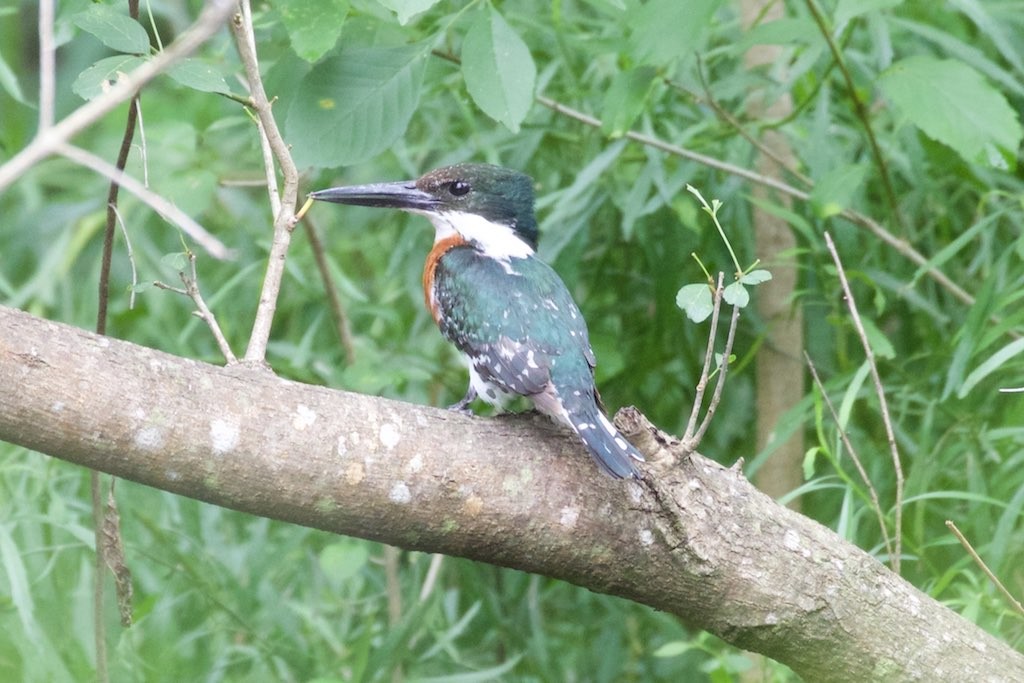Green Kingfisher
A species of American Green Kingfishers Scientific name : Chloroceryle americana Genus : American Green Kingfishers
Green Kingfisher, A species of American Green Kingfishers
Botanical name: Chloroceryle americana
Genus: American Green Kingfishers
Content
Description General Info
Description
The green kingfisher is 20 cm (7.9 in) long. The male weighs 29–40 g (1.0–1.4 oz) and the female 33–55 g (1.2–1.9 oz). It has the typical kingfisher shape, with a short tail and long bill. It is oily green above, with white markings on the wings and tail, and a white collar around the neck. Males have white underparts apart from a broad chestnut breast band and some green spotting on the flanks. Females have buff-white underparts with two green chest bands, the lower of which links to the green spotting along the sides of the belly. These birds often give a pebbly rattling call. 
Size
19-22 cm (7.5-8.75 in)
Life Expectancy
5 years
Nest Placement
Burrow
Clutch Size
3 - 6 eggs
Incubation Period
1 brood
Number of Broods
19 - 21 days
Nestling Period
26 - 27 days
Feeding Habits
Green Kingfisher primarily hunts small freshwater fish by diving from low perches, without full submersion, striking larger prey against perches before consumption. Diet includes fish, shrimp, dragonfly nymphs, waterbugs, ants, with rare hunting by hovering.
Habitat
Green Kingfisher typically resides in a variety of freshwater habitats, from clear, calm rivers to streams in forested regions. These birds prefer environments with abundant hunting perches, such as willow branches or man-made structures, overhanging the water. They dwell at varying altitudes, from near sea level to mountainous regions, and nest in burrows excavated in riverside banks. In the more arid areas of their range, green Kingfisher adapts to habitats like dry creek beds and flooded forests, demonstrating their versatility in both wet and semi-aquatic ecosystems.
Nest Behavior
The green Kingfisher excavate nests together and lay eggs in a simple earthen depression. Parental care includes provisioning the nest with prey remnants, though specific egg-laying patterns and fledging times are less documented.
Nest Characteristics
Green Kingfisher nests in burrows excavated by both adults in river or stream banks. The entrance is just over 2 inches wide, and burrows can extend 3 feet. They are often camouflaged by vegetation and above high-water levels, with bare earth nest depressions.
Dite type
Piscivorous
General Info
Feeding Habits
Bird food type
Behavior
Green Kingfisher exhibit solitary foraging behaviors, typically seen hunting alone. During breeding season, pairs may form but show minimal interaction outside of their nesting activities. Both sexes are territorial, defending river stretches or other water bodies, and are known to engage in aggressive encounters with intruders, including airborne chases and confrontations. Despite occasional interspecific conflicts, green Kingfisher and its congeners coexist in shared habitats to a certain extent. Males and females share parenting duties, such as excavation of the burrow, incubation, and feeding of the offspring. Parent-to-parent burrow communication often involves the male's soft calls. Post-fledging, the juvenile green Kingfisher remain with their parents for several months before the family unit disperses. Notably, pairs may return to and reuse the same nesting burrows in subsequent breeding seasons.
Species Status
Not globally threatened.
